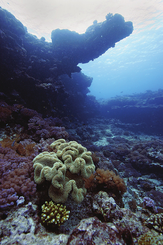An Accidental Sinking

The dive spot, Stuart’s Wreck was named after Stuart Donkin who discovered it. The wreck is a 30m vessel that looks like a tugboat, and after examining the damage on the stern, it seems to have been an accidental sinking. Reef fish and bait fish can be seen on this wreck, and for those observant divers, paperfish can be found. This wreck is also home to a number of rays and guitar sharks.
Average depth: 22 m.
Maximum depth: 27 m
Fontaya
The Fontaya, an old Mozambican trawler that was sunk in 1970, is an excellent penetration wreck. She is also one of three artificial reefs that were created in order to enhance recreational fishing off the KwaZulu-Natal coast. The vessel is 35 m long, 8m wide and 13,5 m high and lies on the sand off the coast from the Umhlanga Rocks lighthouse.
Average dive depth: 24 m.
Maximum depth: 27 m.
A T-shaped Barge
The T-Barge was originally a T-shaped barge with three cranes and it was sunk for an artificial reef in 1970. She is one of three artificial reefs that were created in order to enhance recreational fishing off the KwaZulu-Natal coast. It boasts a multitude of Cauliflower corals, crayfish and goldies. On the sand, one often finds large rays and Guitarfish. The wreck is home to the Harlequin goldie (Conneli), a goldie found only on wrecks in KwaZulu-Natal.
Average depth: 24 m.
Maximum depth: 27 m.
Outer Anchorage
Outer Anchorage used to be the ‘No. 1’ fishing ground in the old days, thus the peculiar name. It is a deep-lying reef with boulders scattered about on a sandy bottom. Anchor chains form interesting patterns on the rock formations. The presence of pelagic fish and sharks make it a good place to dive (this was a popular site and feeding ground for sharks).
Average depth: 25 m.
Maximum depth: 30 m.
Amphitheatre
Amphitheatre is part of the reefs on Outer Anchorage reef and is covered in ships’ anchors and other damaged ship parts. Here you will find caves and overhangs with a huge amount of fish. In the last few years, many Ragged-tooth sharks have made this reef their home and are often spotted here on the dives. Tropical reef fish are also seen on this reef.
Average depth: 27 m.
Maximum depth: 28 m.
Artillery Reef
Artillery Reef is part of the reefs on Outer Anchorage reef and it was named after the amount of ammunition found in this area. Diving here, one can still see 50mm and 88 mm cannon shells lying on the seabed. As it is part of the Outer Anchorage reef there are overhangs, caves and ledges populated by tropical reef fish.
Average depth: 23 m.
Maximum depth: 26 m.
A Thriving Population Of Stinging Hydroids
The mysterious ‘Cooper’s Wreck’ is believed to be a whaler boat that was sunk around 1940. The wreck sits upright on the sand in 33m of water off the Cooper Lighthouse in Brighton Beach. The badly rusted hull is approximately 35m long and is covered with tangled fishing lines. This wreck is home to an abundance of tropical fish, rays and beautiful shells. Beware: a thriving population of stinging hydroids can leave you with a nasty experience.
Average depth: 20 m.
Maximum depth: 33 m.